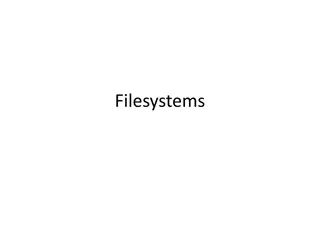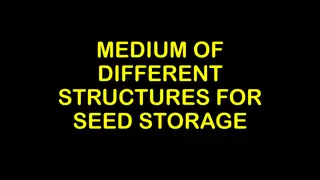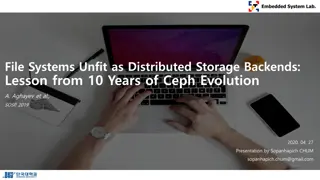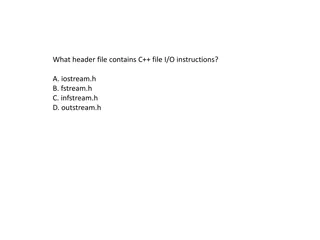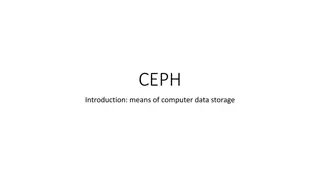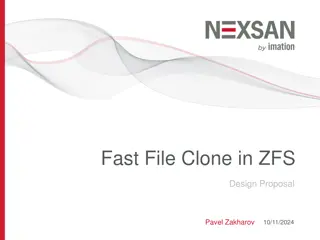Researchers' Shared File Organization Practices in Cloud Storage
Researchers widely use cloud storage for collaborative projects, facing challenges in managing shared files. This study investigates user behavior in organizing shared files to enhance system design. Theoretical frameworks, research questions, methodology, and participant demographics are discussed.
Download Presentation

Please find below an Image/Link to download the presentation.
The content on the website is provided AS IS for your information and personal use only. It may not be sold, licensed, or shared on other websites without obtaining consent from the author.If you encounter any issues during the download, it is possible that the publisher has removed the file from their server.
You are allowed to download the files provided on this website for personal or commercial use, subject to the condition that they are used lawfully. All files are the property of their respective owners.
The content on the website is provided AS IS for your information and personal use only. It may not be sold, licensed, or shared on other websites without obtaining consent from the author.
E N D
Presentation Transcript
Understanding Researchers Shared File Organization Practices in Cloud Storage for Collaborative Projects Kyong Eun Oh School of Library & Information Science Simmons University Boston, USA
Introduction Cloud storage platforms are widely used among researchers for their collaborative projects Despite the obvious benefits, there are challenges Challenges include managing shared files organized by others It is important to understand user behavior that can inform the design of systems that better support shared file management Little is known about researchers shared file organization practices
Theoretical Framework Personal Information Management (PIM) The practice and the study of the activities a person performs in order to acquire or create, store, organize, maintain, retrieve, use, and distribute the information needed to complete tasks and fulfill various roles and responsibilities (Jones, 2007, p. 453) Two Models: Major PIM Activities Finding/re-finding, Keeping, Meta-level activities (Jones, 2007) Exploitation, Keeping, Management (Whittaker, 2011) Previous Literature A number of studies on personal information management Fewer studies examined shared file management in cloud storage
Research Questions Investigate researchers shared file organization practices in cloud storage for collaborative projects 1. What are the researchers primary way of organizing shared files in cloud storage? 2. When do researchers organize shared files in cloud storage? 3. To what extent does the research project team have rules or norms for organizing shared files in cloud storage? 4. How satisfied are researchers with their shared file organization practices? 5. What variables are related to researchers satisfaction?
Methodology Participants 534 researchers who have an ongoing collaborative research project which uses cloud storage Data Collection An online survey distributed to 360 doctoral universities in the U.S. Data Analysis Statistical analyses
Methodology Variable Value # % Male 180 35.2% Gender Female 313 61.3% Non-Binary 18 3.5% 20s 214 41.9% Age Group 30s 152 29.7% 40s 77 15.1% 50s 47 9.2% 60+ 21 4.1% Asian 84 16.6% Ethnicity Black/African American 15 3.0% Latino/Hispanic 33 6.5% White/Caucasian 351 69.4% Other 23 4.6%
Methodology Variable Value # % Arts & Humanities 110 21.5% Academic Discipline Sciences 185 36.1% Social Sciences 214 41.8% Graduate Student 296 57.9% Job Title Postdoc and Other 57 11.2% Professor 158 30.9% Principal Investigator (PI)/Co-PI 226 44.1% Role in the Project Research Assistant (RA) 156 30.5% Researcher and Other 130 25.4%
Results The primary way of organizing shared files (N = 524) In folders based on tasks 23.5 As a list based on file name 21.4 In folders based on research phases 17.4 Using multipe methods 13.2 As a list based on the last updated date 9.2 0.0 5.0 10.0 15.0 20.0 25.0
Results When most likely to organize shared files (N = 520) When the cloud storage looks cluttered/messy 22.1 When creating a new file 21.7 When there is a new task 21.7 When you are done with a certain task 11.7 Not at all 9.4 When you cannot find the files you need 8.3 Regularly 5.0 0.0 5.0 10.0 15.0 20.0 25.0
Results Having rules or norms for organizing shared files 40.5 None 44.0 50.7 45.5 There are implicit norms 41.8 34.3 14.0 There are explicit rules 12.0 11.8 0 10 20 30 40 50 60 Organizing files/folder structures Naming conventions Controling different versions
Results Satisfaction with shared file organization practices (7-point Likert scale) Slightly or moderately satisfied (M = 5.37, SD = 1.66) Related variables Variables Significant Post-hoc Pairs Primary way of organizing files X When most likely to organize files - Creating a new file (M=5.61) vs Cannot find files (M=4.30) - Done with a certain task (M=5.61) vs Cannot find files (M=4.30) - There is a new task (M=5.50) vs Cannot find files (M=4.30) O Rules or norms for organizing files/folder structures - Rules (M=5.76) vs None (M=5.04) - Norms (M=5.54) vs None (M=5.04) O Rules or norms for naming conventions of files X Rules of norms for controlling different versions of files - Rules (M=5.77) vs None (M=5.15) - Norms (M=5.55) vs None (M=5.15) O
Results Satisfaction with shared file organization practices (7-point Likert scale) Slightly or moderately satisfied (M = 5.37, SD = 1.66) Related variables Variables Significant Post-hoc Pairs Primary way of organizing files X When most likely to organize files - Creating a new file (M=5.61) vs Cannot find files (M=4.30) - Done with a certain task (M=5.61) vs Cannot find files (M=4.30) - There is a new task (M=5.50) vs Cannot find files (M=4.30) O Rules or norms for organizing files/folder structures - Rules (M=5.76) vs None (M=5.04) - Norms (M=5.54) vs None (M=5.04) O Rules or norms for naming conventions of files X Rules of norms for controlling different versions of files - Rules (M=5.77) vs None (M=5.15) - Norms (M=5.55) vs None (M=5.15) O
Results Satisfaction with shared file organization practices (7-point Likert scale) Slightly or moderately satisfied (M = 5.37, SD = 1.66) Related variables Variables Significant Post-hoc Pairs Primary way of organizing files X When most likely to organize files - Creating a new file (M=5.61) vs Cannot find files (M=4.30) - Done with a certain task (M=5.61) vs Cannot find files (M=4.30) - There is a new task (M=5.50) vs Cannot find files (M=4.30) O Rules or norms for organizing files/folder structures - Rules (M=5.76) vs None (M=5.04) - Norms (M=5.54) vs None (M=5.04) O Rules or norms for naming conventions of files X Rules of norms for controlling different versions of files - Rules (M=5.77) vs None (M=5.15) - Norms (M=5.55) vs None (M=5.15) O
Results Satisfaction with shared file organization practices (7-point Likert scale) Slightly or moderately satisfied (M = 5.37, SD = 1.66) Related variables Variables Significant Post-hoc Pairs Primary way of organizing files X When most likely to organize files - Creating a new file (M=5.61) vs Cannot find files (M=4.30) - Done with a certain task (M=5.61) vs Cannot find files (M=4.30) - There is a new task (M=5.50) vs Cannot find files (M=4.30) O Rules or norms for organizing files/folder structures - Rules (M=5.76) vs None (M=5.04) - Norms (M=5.54) vs None (M=5.04) O Rules or norms for naming conventions of files X Rules of norms for controlling different versions of files - Rules (M=5.77) vs None (M=5.15) - Norms (M=5.55) vs None (M=5.15) O
Discussion Primary way of organizing shared files Both folders and lists were heavily used When most likely to organize shared files Often organized based on ad hoc needs rather than by following rules or plans
Discussion Primary way of organizing shared files Both folders and lists were heavily used When most likely to organize shared files Often organized based on ad hoc needs rather than by following rules or plans Rules or norms for organizing shared files More than 40% responded that they don t have any Less than 15% had explicit rules Variables related to satisfaction with organizing shared files Lower satisfaction when there is no rules or norms Lower satisfaction when most likely to organize files when they cannot find needed files
Conclusion Implications of the study A large-scale study with researchers across disciplines Deepens our understanding of shared file organization practices for collaborative research projects Contributes to literatures on PIM and information behavior Informs the design of systems and tools Limitations of the study Couldn t delve into different practices and underlying reasons Further Research Analyzing researchers shared file organization practices, challenges, and strategies from in-depth interviews *This study is supported by the grant from the Alfred P. Sloan Foundation (#G-2021-16833)
Conclusion Implications of the study A large-scale study with researchers across disciplines Deepens our understanding of shared file organization practices for collaborative research projects Contributes to literatures on PIM and information behavior Informs the design of systems and tools Limitations of the study Couldn t delve into different practices and underlying reasons Further Research Analyzing researchers shared file organization practices, challenges, and strategies from in-depth interviews *This study is supported by the grant from the Alfred P. Sloan Foundation (#G-2021-16833)
Thank You kyongeun.oh@simmons.edu



